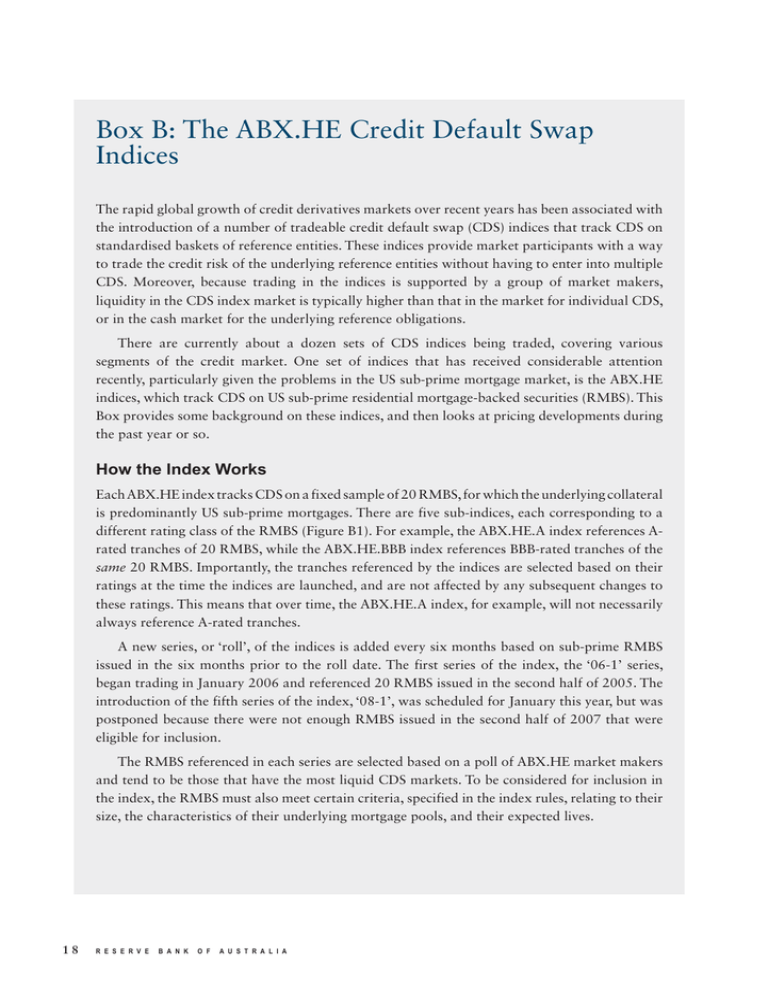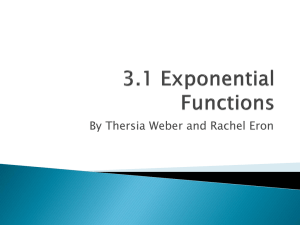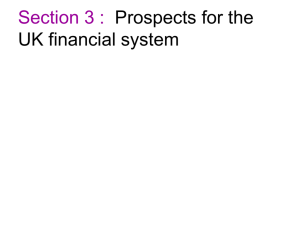Box B: The ABX.HE Credit Default Swap Indices
advertisement

Box B: The ABX.HE Credit Default Swap Indices The rapid global growth of credit derivatives markets over recent years has been associated with the introduction of a number of tradeable credit default swap (CDS) indices that track CDS on standardised baskets of reference entities. These indices provide market participants with a way to trade the credit risk of the underlying reference entities without having to enter into multiple CDS. Moreover, because trading in the indices is supported by a group of market makers, liquidity in the CDS index market is typically higher than that in the market for individual CDS, or in the cash market for the underlying reference obligations. There are currently about a dozen sets of CDS indices being traded, covering various segments of the credit market. One set of indices that has received considerable attention recently, particularly given the problems in the US sub-prime mortgage market, is the ABX.HE indices, which track CDS on US sub-prime residential mortgage-backed securities (RMBS). This Box provides some background on these indices, and then looks at pricing developments during the past year or so. How the Index Works Each ABX.HE index tracks CDS on a fixed sample of 20 RMBS, for which the underlying collateral is predominantly US sub-prime mortgages. There are five sub-indices, each corresponding to a different rating class of the RMBS (Figure B1). For example, the ABX.HE.A index references Arated tranches of 20 RMBS, while the ABX.HE.BBB index references BBB-rated tranches of the same 20 RMBS. Importantly, the tranches referenced by the indices are selected based on their ratings at the time the indices are launched, and are not affected by any subsequent changes to these ratings. This means that over time, the ABX.HE.A index, for example, will not necessarily always reference A-rated tranches. A new series, or ‘roll’, of the indices is added every six months based on sub-prime RMBS issued in the six months prior to the roll date. The first series of the index, the ‘06-1’ series, began trading in January 2006 and referenced 20 RMBS issued in the second half of 2005. The introduction of the fifth series of the index, ‘08-1’, was scheduled for January this year, but was postponed because there were not enough RMBS issued in the second half of 2007 that were eligible for inclusion. The RMBS referenced in each series are selected based on a poll of ABX.HE market makers and tend to be those that have the most liquid CDS markets. To be considered for inclusion in the index, the RMBS must also meet certain criteria, specified in the index rules, relating to their size, the characteristics of their underlying mortgage pools, and their expected lives. 18 R E S E R V E B A N K O F A U S T R A L I A Figure B1: Composition of the ABX.HE Indices RMBS 1 RMBS 2 RMBS 20 AAA AAA AAA ABX.HE.AAA AA AA AA ABX.HE.AA A A A An index referencing CDS on 20 A-rated sub-prime RMBS tranches ABX.HE.A BBB BBB BBB ABX.HE.BBB BBBEquity BBBEquity BBBEquity ABX.HE.BBB- Source: RBA At their launch, each ABX.HE index contract has a fixed notional amount and the 20 underlying RMBS tranches are equally weighted. As the tranches are paid down or experience write-downs, the notional amount of each index declines proportionately. As with a CDS, entering into an ABX.HE index contract is analogous to buying or selling insurance on the underlying RMBS tranches. An investor wanting to hedge an existing position, or otherwise establish a short credit position using the index (known as the ‘protection buyer’), is required to pay a monthly premium to the other party (the ‘protection seller’). These premiums are calculated based on the outstanding notional amount of the index and a fixed premium rate, with the premium rate determined at the launch of each ABX.HE index based on an average quote from the market makers. The ABX.HE indices that reference lower-rated RMBS tranches typically carry higher premium rates than those referencing higher-rated tranches due to the higher expected likelihood of default. In return for the premiums, the protection buyer in an ABX.HE index contract is compensated by the protection seller when any interest or principal shortfalls or write-downs on the underlying mortgages affect the constituent RMBS. Unlike with a conventional CDS, the index contract does not terminate when these credit events occur; rather it continues with a reduced notional amount until maturity. If credit events are subsequently reversed – for example, a principal shortfall is made up – then the protection buyer reimburses the protection seller. Unlike most other CDS indices, the ABX.HE indices are traded on a price basis, rather than a spread basis. Because the premium rate on each ABX.HE index is fixed at its launch, the market prices of the indices adjust to reflect changes in risk aversion or the market’s assessment F I N A N C I A L S T A B I L I T Y R E V I E W | M A R C H 2 0 0 8 19 of the default risk on the underlying RMBS. A price below par implies that the market cost of protection has increased since the index was launched. In this case, in addition to the monthly premiums based on the fixed premium rate, someone wanting to buy protection by entering into an ABX.HE contract would have to make a one-off upfront payment to the protection seller. For example, if the price of the index was quoted at 90 per cent of par, then the protection buyer would pay 10 per cent of the index notional amount to the protection seller. By contrast, if the index was quoted at 110 per cent of par, then the protection buyer would receive 10 per cent of the index notional amount from the protection seller, and thereafter pay the premium based on the fixed premium rate. While the main users of the ABX.HE indices are investors wanting to either hedge, or gain exposure to, the credit risk on US sub-prime mortgages, there is also scope to use the indices for various relative-value trading strategies. For example, an investor that held the view that the A-rated tranches of the sub-prime RMBS would perform better, and the BBB-rated tranches worse, than market prices suggested, could buy protection on the ABX.HE.BBB index while simultaneously selling protection on the ABX.HE.A index. Similarly, it is possible to enter into relative-value trades based on the various vintages of the ABX.HE indices. Pricing Developments Graph B1 Prices of ABX.HE Indices Per cent of par % % 06-1 100 100 AAA AA A 50 BBB BBB- 50 % % 06-2 100 100 50 50 % % 07-1 100 100 50 50 % % 07-2 100 100 50 50 0 l Mar l l Jun Sep 2006 l Dec Mar l Jun Sep 2007 Source: JPMorgan 20 R E S E R V E B A N K O F A U S T R A L I A l Dec Mar 2008 0 As noted above, there have been four series of the ABX.HE indices launched since January 2006. All of them have recorded considerable price falls since their introduction, associated with the deteriorating conditions in the US sub-prime mortgage market and the general rise in risk aversion (Graph B1). Prices for the ‘BBB’ and ‘BBB-’ sub-indices of all the vintages are currently being quoted at around 10–15 per cent of par. This means that someone buying protection would have to pay about 85–90 per cent of the notional amount upfront, in addition to the ongoing premiums. Such a high upfront payment suggests that the market expects a significant loss of principal on the underlying RMBS tranches within a relatively short space of time. The prices of the sub-indices referencing higherrated tranches of the RMBS have not fallen by as much, reflecting their greater protection via subordination, although even the ‘AAA’ sub-indices of the two most recent series are currently being quoted below 60 per cent of par. Comparing vintages, the prices of the newer indices have tended to fall by more than the older indices, consistent with the fact that sub-prime mortgages originated more recently are showing a worse arrears performance (after adjusting for seasoning effects) than those originated earlier. In most cases, the fixed premium rates for the newer indices are also considerably higher than for the older indices (Table B1). In the ‘07-2’ series, the fixed premium rates for the ‘BBB’ and ‘BBB-’ sub-indices both reached 500 basis Table B1: ABX.HE Fixed Premium Rates points, which is the ceiling imposed Annual, basis points by the index rules, and consequently, Series both these indices began trading substantially below par. 06-1 06-2 07-1 07-2 ABX.HE.AAA 18 11 9 76 To compare the performance of ABX.HE.AA 32 17 15 192 the different vintages across time, the ABX.HE.A 54 44 64 369 market prices need to be converted ABX.HE.BBB 154 133 224 500 ABX.HE.BBB267 242 389 500 into an implied spread, given the Source: Markit change in the fixed premium rates across different series. This can be Graph B2 done using assumptions about the expected duration of the underlying Implied Spreads on ABX.HE.AAA Indices Bps Bps RMBS. Graph B2 shows implied spreads estimated by JPMorgan 1000 1000 for the four vintages of the 07-2 800 800 ABX.HE.AAA index. After averaging 06-2 less than 20 basis points in the first 600 600 half of 2007, the implied spreads on 07-1 these indices increased dramatically 400 400 in the second half of 2007, and 200 200 have risen further over the past 06-1 few months. Spreads on the newer l l l l l l l l l l l l l 0 0 vintages of the ABX.HE.AAA index Mar Jun Sep Dec Mar 2007 2008 Source: JPMorgan are significantly higher than those on the older vintages, consistent with the relative performance of the underlying mortgage pools noted earlier. For the ‘07-2’ series, the implied spread has risen to about 1 100 basis points. Implied spreads on the ‘BBB’ and ‘BBB-’ sub-indices are exceptionally high at the moment, in most cases above 10 000 basis points. In interpreting these movements, it is important to note that the RMBS tranches referenced by these indices are not always at the top of their respective capital structures. For example, the senior part of the capital structure of an RMBS often consists of a number of AAA-rated tranches of varying duration. The tranches referenced in the ABX.HE indices have typically been F I N A N C I A L S T A B I L I T Y R E V I E W | M A R C H 2 0 0 8 21 the longer-duration of these, which still benefit from the subordination provided by the more junior classes, but are more risky than the other AAA-rated tranches. This could partly explain why the prices of the ‘AAA’ sub-indices of the ABX.HE may be at levels that do not appear commensurate with the expected losses on all the AAA-rated classes of the sub-prime RMBS. The declines in the prices of the ABX.HE indices have been associated with rating downgrades to a number of the constituent RMBS tranches, particularly those that were lower rated to begin with. For example, most of the A, BBB and BBB- tranches referenced by the ‘07-1’ index are now rated CCC or lower, though fewer of the AAA-rated tranches have been downgraded. Because liquidity in the cash markets for many structured credit products has been quite low, particularly since the onset of the current credit market turbulence, the ABX.HE indices have been one of the few sources of pricing information for sub-prime related securities. As a result, many investors have been using the indices as a reference point for valuing their, often more diverse, holdings of sub-prime related securities. The sharp falls in the prices of the ABX.HE indices over the past year or so have therefore played a part in the large credit writedowns that some financial institutions have recently been reporting. There is, however, a growing concern that the prices of the ABX.HE indices, particularly the ‘AAA’ sub-indices, may be giving an unrealistic signal of the losses likely to be sustained on the underlying RMBS, which is prompting some to question the use of these indices in valuation models. According to one estimate, the recent prices of the ABX.HE indices imply cumulative losses of about one third on the constituent RMBS. One way this could occur would be if two thirds of mortgage holders defaulted, and the average recovery rate was only half of the mortgage values. This would be many times worse than historical experience and implies a very significant fall in US house prices. Those questioning the use of ABX.HE indices in valuation models have also focused on the fact that the indices capture only a very narrow slice of the market – 20 underlying RMBS versus the 50–100 that were typical in ABS CDOs produced in recent years – and that the prices may be prone to distortion given the relatively thin trading seen recently. R 22 R E S E R V E B A N K O F A U S T R A L I A




![[#EXASOL-1429] Possible error when inserting data into large tables](http://s3.studylib.net/store/data/005854961_1-9d34d5b0b79b862c601023238967ddff-300x300.png)

